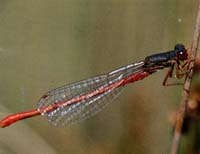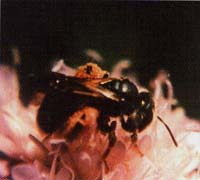RIGS Group
Summertime ... and the living is easy ...
Ten summers ago the Trust's geoconservation
group (the RIGS Group) was being dreamt up. Forty summers ago the Trust's
earliest incarnation, the Cornwall Naturalists' Trust (later the Cornwall
Trust for Nature Conservation) was set up. The remit - nature conservation
- was always meant to include both biodiversity and geodiversity (though
those words had not been released yet on an eager world) - it's
just that the geologists took their time. That's geologists for you! But
what about future summers? Will the Cornwall Wildlife Trust, or whatever
it is
called then, bask in Mediterranean -or Newfoundland-like - summers? Certainly the present membership will never know, so let's look back a few years - a few years in geological time.
Ten thousand years ago our present
interglacial was beginning, with rapid warming, and as the ice melted
sea level rose, much later to submerge the forests we now find as logs
and peats around the coast at places like Marazion, Praa, Pendower, Portreath
and Duckpool. How about one hundred thousand years ago? What was Cornwall
like then? Your wildlife garden could have had woolly mammoths, woolly
rhinoceros, reindeer and bears wandering through. And instead of
hunting for elusive water voles you would probably have had little trouble finding lemmings. But what about the climate? Think of coastal Spitsbergen, or anywhere south of an ice sheet but near an ocean. And what about digging in your garden? Permafrost! Just the top melted in summertime, though it might have all sludged off downslope (we call the deposit "head"; it's the jumble of soil and stones we see in the cliffs above the slate or granite bedrock). So, "Summertime ... and the garden is sludgy" would be a suitable song for Cornish wildlife gardeners in any of the glacial periods of the last i couple of million years, i
John Macadam

The biggest event undertaken so far this year was the six-week exhibition of members' work at the Royal Cornwall Museum. I regard this as a major success in ¦ terms of raising the profile of B the group as well as that of a wildlife and the Trust. I am p grateful to all of the members who contributed images, as
I well as to all of those people who contacted me to let me know they had enjoyed looking at them. Plans are now afoot to move the exhibition to other locations during the year.
We have had just two meetings since the new year, both of which have been well attended. It has been very encouraging to
see the growth in popularity of the group over the last couple of years. We can now be assured of around twenty people at our meetings. In March we welcomed Martin Catt, who came all the way from Devon. He gave a talk on the countryside the way he sees it and made some very interesting points for us to think about.
I am now looking forward to summer's field trips and would like to offer a warm welcome to any budding photographers out there. Whether experienced or not, please come along and have a good day out.
David Chapman
Living Churchyards
It's good to report that we have received funding from the Cornwall and Isles of Scilly Community Fund towards printing a new leaflet for the project.
The last year has had its ups and downs. A recent fatal accident in Yorkshire has resulted in local and parish councils in charge of closed churchyards considering laying flat many headstones that might be deemed dangerous. This puts me in mind of the period when memorials were placed around the perimeter of
churchyards without a thought for the mini-habitats being spoiled and lichens lost. The newly formed Botanical Cornwall Group is to make its concerns known to councils but do speak out if it is happening near you.
Chris Haes discovered a large colony of mining bees, the rare Andrena hattorfiana, at St Uny Leiant. The churchyard is to be closed and maintenance taken over by Penwith District Council so we will monitor the effects of new management with interest. Carol Simpson
Andrena hattorfiana, has found refuge at St Uny Lelant. Photo: Chris Haes
